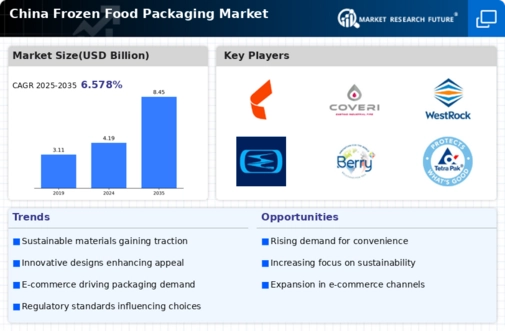Rising Demand for Convenience Foods
The increasing pace of urbanization in China appears to drive a notable rise in demand for convenience foods, which in turn influences the frozen food-packaging market. As lifestyles become busier, consumers are seeking quick meal solutions that do not compromise on quality. This trend is reflected in the growth of the frozen food sector, which has expanded by approximately 15% annually over the past few years. The frozen food-packaging market is adapting to this demand by offering packaging that enhances convenience, such as easy-open features and microwave-safe materials. Furthermore, the preference for ready-to-eat meals is likely to continue, suggesting that the packaging solutions must evolve to meet the expectations of time-strapped consumers.
Health Consciousness Among Consumers
There is a growing trend of health consciousness among Chinese consumers, which is influencing their purchasing decisions in the frozen food-packaging market. As more individuals become aware of nutritional information and ingredient sourcing, there is a demand for packaging that clearly communicates these aspects. Products that are labeled as organic, low-calorie, or free from artificial additives are gaining traction. This shift is reflected in the market, where health-oriented frozen food products have seen a growth rate of approximately 10% annually. Consequently, packaging that highlights health benefits and ingredient transparency is becoming increasingly important in attracting consumers and driving sales in the frozen food-packaging market.
E-commerce Growth and Online Shopping
The rapid expansion of e-commerce in China is reshaping the landscape of the frozen food-packaging market. With more consumers opting to purchase groceries online, there is a heightened need for packaging that ensures product integrity during transit. The online grocery market has experienced a growth rate of around 25% in recent years, indicating a shift in consumer behavior. This trend necessitates the development of packaging solutions that are not only visually appealing but also robust enough to withstand shipping conditions. As e-commerce continues to flourish, the frozen food-packaging market must adapt to meet the logistical challenges posed by online sales, ensuring that products arrive in optimal condition.
Technological Advancements in Packaging
Technological innovations in packaging materials and processes are significantly impacting the frozen food-packaging market. The introduction of advanced materials, such as biodegradable plastics and vacuum-sealed packaging, enhances product shelf life and reduces food waste. In China, the market for smart packaging technologies is projected to grow by 20% over the next five years, indicating a shift towards more sophisticated solutions. These advancements not only improve the preservation of frozen foods but also provide consumers with valuable information regarding freshness and storage. As technology continues to evolve, the frozen food-packaging market is likely to see increased investment in research and development to create more efficient and sustainable packaging options.
Regulatory Changes and Environmental Standards
Regulatory changes in China regarding environmental standards are increasingly influencing the frozen food-packaging market. The government has implemented stricter regulations aimed at reducing plastic waste and promoting sustainable practices. As a result, manufacturers are compelled to explore alternative materials and innovative packaging solutions that comply with these regulations. The shift towards eco-friendly packaging is not merely a compliance issue; it also represents a growing consumer preference for sustainable products. This trend is likely to drive investment in research and development within the frozen food-packaging market, as companies seek to align their offerings with both regulatory requirements and consumer expectations for environmentally responsible packaging.





















Leave a Comment